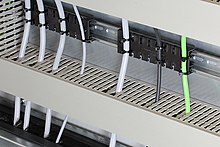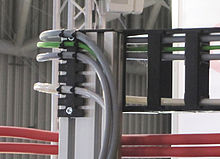Strain relief
A strain relief is a mechanical protection device for flexible electrical cables and hoses .
The strain relief for portable electrical equipment is standardized according to EN 62444 (formerly EN 50262).
Strain relief is often metal or plastic clamps that protect flexible electrical connection cables ( stranded wires ) from being torn out. The cables are clamped for this. Even cable glands may have a strain relief function.
Another method is to fix cables to special strain relief strips using cable ties . Such strain relief strips are widespread in industrial applications because their packing density is higher than with conventional cable clamps, which are only designed for individual lines. With this method, the range of outer diameters of the cables is greater than with clamps or screw connections.
Strain relief must be available for portable electrical equipment, the tensile strength is prescribed - depending on the mass of the devices. This also includes the connectors on extension cables and flexible multiple sockets.
Components for strain relief are also used in applications in which cables and hoses are subjected to an intended or compulsory permanent load, e.g. B. in energy chains .
See also
literature
- Alfred Hösl, Roland Ayx, Hans Werner Busch: The electrical installation in accordance with regulations, residential construction, commercial industry. 18th edition, Hüthig Verlag, Heidelberg, 2003, ISBN 3-7785-2909-9
- Heinz O. Häberle: Introduction to electrical installation. 3rd edition, Hüthig & Pflaum Verlag, Munich / Heidelberg, 2003, ISBN 3-8101-0164-8
Individual evidence
- ↑ DIN EN 62444 VDE 0619: 2014-05 - Standards - VDE VERLAG. In: www.vde-verlag.de. Retrieved September 16, 2015 .
- ↑ DIN EN 50262 VDE 0619: 2005-05 - Standards - VDE VERLAG. In: www.vde-verlag.de. Retrieved September 16, 2015 .


